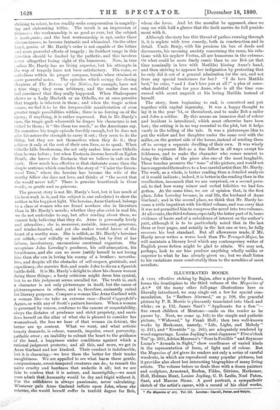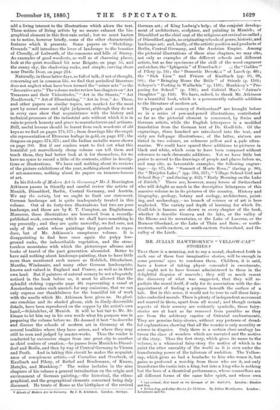ILLUSTRATED BOOKS.
A VERY effective etching by Rajon, after a picture by Bonnat, forms the frontispiece to the third volume of the Magazine of Art.* Of the many other full-page illustrations here so liberally introduced, we may single out a few for special com- mendation. In " Bathers Alarmed," on p. 108, the graceful picture by P. R. Morris is pleasantly translated into black and white ; on p. 132, James Sant's "Applicants for a Son "- five sweet children of Mentone—smile on the reader as he passes by. Next, we .come (p. 161) to the simple and pathetic picture, "Widowed," by Frank Holl ; then two well-known works by Herkomer, namely, " Life, Light, and Melody " (p. 241), and " Eventide " (p. 261), are adequately rendered by wood-engravings. Louise Jopling's semi-Japanese" Five o'clock Tea" (p. 281), AdrienMoureau's " Sous la Fenill6e " and Seymour Lucas's "Armada in Sight," show excellences of varied kinds in the representation of form, of light and of colour. But the Magazine of Art gives its readers not only a series of careful woodcuts, in which are reproduced many popular pictures, but it provides also short but interesting biographies of many living artists. The volume before us deals thus with a dozen painters and sculptors, Armstead, Boehm, Fildes, Gerome, Herkomer, Holl, Holman Hunt, Louise Jopling, G. D. Leslie, Noel Paton, Sant, and Marcus Stone. A good portrait, a sympathetic sketch of the artist's career, with a record of his chief works, • The Magasine of Art. Vol. III. London : Cassell, Potter, and Galpin.
add a living interest to the illustrations which adorn the text. These notices of living artists by no means exhaust the bio- graphical element in this first-rate serial ; but we must hasten on to notice, however briefly, some of the other characteristic features which it presents. Some papers on " Sketching- Grounds " will introduce the lover of landscape to the beauties of Clovelly, of Lulworth, of the commons and hills of Surrey. As examples of good woodcnts, as well as of charming places, look at the quiet woodland bit near Reigate, ou page 55, and the sunny sky, the shadowing rocks, and simple, curving shore near Durdle Door, on page 214.
Naturally, in these latter days, so full of talk, if not of thought, concerning art in common life, we find that periodical literature does not neglect what have been termed the " minor arts " or the " decorative arts." The volume under review has chapters on" Art Treasures and their Vicissitudes," " Art .in the Streets," " Art Needlework," "Art of Illuminating," "Art in Iron," &c. These, and other papers on similar topics, are marked for the most part by sound sense and right judgment, although they do not in every case show that acquaintance with the history and technical processes of the industrial arts without which it is in vain to preach honesty and grace to manufacturers and artisans. Still, useful lessons should be learnt from such woodcuts of old keys as we find on pages 174,175 ; from drawings like the exqui- site representation of Etruscan leafage in gold, on page 197 ; the dragons on pages 374, 375; and the Indian metallic wares shown on page 309. But if our readers want to find out what this beautiful yet marvellously cheap volume can tell them and teach them, they had better look at it for themselves, for we have no space to record a tithe of its contents, either in descrip- tions or illustrations. We have said nothing about its reviews of the picture exhibitions of the year, nothing about its accounts of art-museums, nothing about its papers on treasure-houses of art.
In his Schools of Modern Art in Germany,* Mr. J. Beavington Atkinson passes in friendly and careful review the artists of Munich, Dusseldorf, Berlin, Central Germany, and Austria. We say the artists, but we ought to limit our statement. German landscape art is quite inadequately treated in this volume. Out of its forty-two illustrations but two are pure landscape, and those are by E. T. Compton, an Englishman. Moreover, these illustrations are borrowed from a recently- published work, concerning which we shall have something to say presently ; and they are quite unworthy, we feel sure, not only of the artist whose paintings they pretend to repro- duce, but of Mr. Atkinson's sumptuous volume. It is disappointing to find here once again the pulpy fore- ground rocks, the indescribable vegetation, and the struc- tureless mountains with which the picturesque albums and books of travel of the past generation abounded. Better to have said nothing about landscape-painting, than to have little more than mentioned such names as Hofelich, Ditscheiner, Munthe, Windmaier, and many other German landscapists, known and valued in England and France, as well as in their own land. But if painters of natural scenery he not adequately noticed in the book before us, it must be allowed that the splendid etching (opposite page 48) representing a canal at Amsterdam makes such amends for any omissions, that we can only express our thankfulness for the beautiful bit of work with the needle which Mr. Atkinson here gives us. Its glori- ous sunshine and its shaded gloom, rich in dimly-discernible details, have been reproduced on the copper by the artist's own hand,—Schonleber, of Munich. It will be but fair to Mr. At- kinson to let him say in his own words what his purpose was in preparing the volume before ns. He deemed it best " to describe and discuss the schools of modern art in Germany at the several localities where they have arisen, and where they may still be seen and judged by master-works. Thus the reader is conducted by successive stages from one great city to another as chief centres of creation,—he passes from Munich to Dussel- dorf and Berlin, and then by way of Central Germany to Vienna and Peath. And in taking this circuit he makes the acquaint- ance of conspicuous artists,—of Cornelius and Overbeck, of Kaulbach and Piloty, of Rethel and Bendemann, of Knaus, Matejko, and Munkiicsy." The writer includes in the nine chapters of his volume a general introduction on the origin and environment of German painting,—the historical, the ethno- graphical, and the geographical elements concerned being duly discussed. He treats of Rome as the birthplace of the revived • Schools of Modern Art to Germany. By J. B. Atkinson. London : Seeley,. German art ; of King Ludwig's help ; of the conjoint develop- ment of architecture, sculpture, and painting in Munich; of Diisseldorf as the chief seat of the religious art revival so-called ; of Dusseldorf, again, as originating schools of genre, historic, and landscape art; and, lastly, of the artistic positiou and products of Berlin, Central Germany, and the Austrian Empire. Among- the pictorial illustrations of these nine chapters, we may cite, not only as examples of the different schools and different artists, but as fine specimens of the skill of the wood engraver
and etcher, the "Iphigenia" of Feuerbach ; the" Galileo of Piloty (p. 34); the " Domestic Devotiswa " of Leech (p. 48) ; the " Sick Lion " and Friezes of Kaulbach (pp. 95, 98, 99); the " Bringing Home the Bride " of Stienle (p. 110); Scheyer's " Posting in Wallachia " (p. 118); Munkiksy's " Pre- paring for School" (p. 138); and Gabriel Max's " Jairus's Daughter" (p. 144). We have, indeed, to thank Mr. Atkinson for a beautiful book, which is a permanently valuable addition to the literature of modern art.
The people and scenery of Switzerland* are brought before us in a series of pen-and-pencil illustrations, contributed so far as the pictorial element is concerned, by Swiss and German artists, while the English letterpress is a modified translation from the German text of Dr. Gsell-fels. Of the engravings, three hundred are introduced into the text, and sixty are full-page illustrations ; of the latter, sixteen are tinted in two colours, an ochreous yellow and a pale ultra- marine. We could have spared these additions to pictures in black and white, which seem to have been composed without reference to such chromatic additions. Yet we have little but praise to accord to the drawings of people and places before us, and may cite, as favourable examples, the following engrav- ings :—(p. 87), the " Summit of Monte Rosa ;" (facing p. 96), the " Miirjelen Lake;" (pp. 316, 317), "Village School Girl and School Boy ;" and (facing p. 452)," Early Morning on the Lake of Zurich." There are, however, many lovers of Switzerland who will delight as much in the descriptive letterpress of this massive volume as in its pictures of the country. History and biography, geology, botany and zoology, architecture, paint- ing, and archmology,—no branch of science or of art is here neglected. The variety and depth of learning for which Dr. Gsell-fels is famous are shown in every chapter of the book, whether it describe Geneva and its lake, or the valley of the Rhone and its mountains, or the Lake of Lucerne, or the Bernese Oberland, or the Lake of ThAn and Bern ; or north- western, north-eastern, or south-castern Switzerland, and the valley of the Liuth.







































 Previous page
Previous page